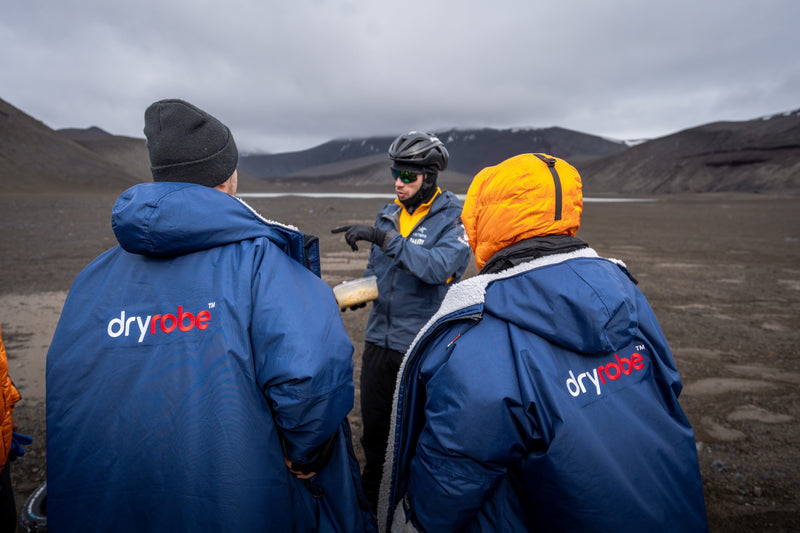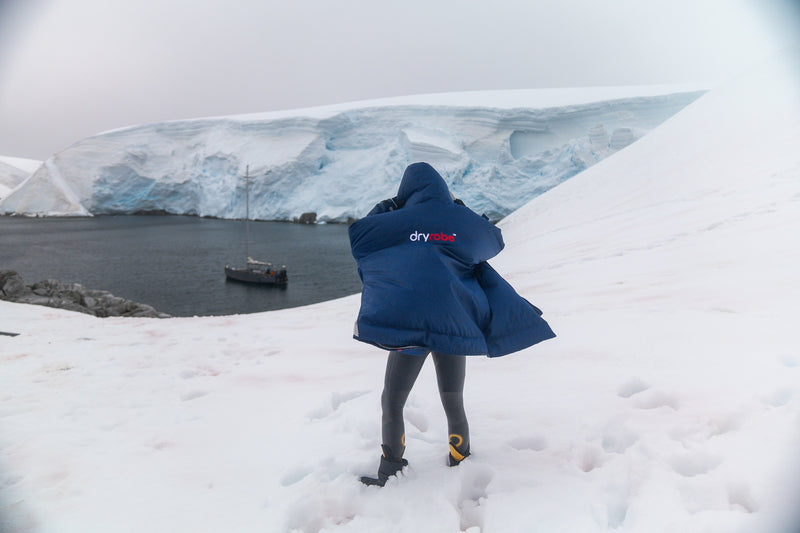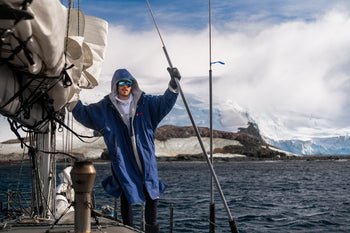14 minute read
It started as a dream and finished as a world record achievement.
What began as a commitment to complete one IRONMAN race, the interference of the pandemic changed Connor Emeny’s course of action and kickstarted a mission of a lifetime. Four years later, he became the first person in the world to complete an Iron Distance Triathlon on all seven continents.
Widely acknowledged as ‘the hardest single-day sporting event on the planet’ an IRONMAN race consists of a 3.86km swim, 180km bike ride, and 42.2km run. Connor ended up doing this seven times in seven unforgiving environments. That’s roughly over 27km of swimming, 1260km of cycling, and 295km of running - plus the other challenges Connor took on in training and preparation!
From the physical strain, the mental perseverance, and just general logistics, how does someone make a momentous achievement like this a reality?
Connor’s journey is truly inspiring, and we jumped at the chance to talk to him about how his dream developed, the motivation behind it and to learn about his final and most extreme challenge in Antarctica that made him the first person in the world to achieve such an esteemed status and world record title.

Congratulations on becoming the first person in the world to complete an Iron-Distance Triathlon on all seven continents! How do you choose the locations for the Iron-distance triathlons? And were there any locations you were particularly apprehensive about?
I just wanted to do one triathlon, and it was like a bucket list item because a friend of mine did one and I thought, ‘That’s impossible. How can somebody do that?’
I started looking up races - if I was going to do one, I wanted to make sure it was a great experience. I saw New Zealand was like the Gold Label award for the best IRONMAN in the world, so that’s the one I signed up for. I quit my job, moved there, lived there for six months, and just trained for this triathlon.
That was 7th March 2020 and then 10 days later the pandemic hit and that’s when I got stranded…I guess the silver lining was it gave me time to come up with this new idea of seven continents. And so my strategy was more just to find the ones that aligned with the timeline the fastest. I didn’t get much selection, there is only one choice in Africa and two or three in Asia. To be honest with you, five out of the six I originally signed up for cancelled or changed so my intention to do the race in the place I wanted didn’t actually work, so it was just adapting.
And then in terms of being apprehensive, I’d probably say the Philippines. I didn't know what to expect there and it was the hardest race out of pretty much all of them because it was so hot and I had no idea my body would react the way it did. I lost 10lbs, I went to the medic tent and also my bike didn’t arrive when I made it to the Philippines.
Prior to this, did you have any experience in triathlons?
No, I grew up playing hockey and then I got into a good school in Canada and I decided to hang up the skates and just try something else.
I started trying out for random club teams, one was the rowing team and one was the triathlon team. Long story short, I ended up making the triathlon team but it was all very short course distance though, like a 15-minute run, bike, and swim.
One of the guys we were racing with, a friend of mine, just went off and did this IRONMAN and I just thought ‘That’s incredible, I wonder if I can do that.’ And texted him in 2015 and by 2020 I’done my first IRONMAN.

In Antarctica, you completed a 3.9km swim, 180km bike, and 42.2km run. What were the most challenging parts of it?
I’d say, the swim was just physical torture. I walked in there and it was minus 1-degree water temperature, and I immediately got goosebumps and I was like ‘Oh no, this is going to be hard.’
Obviously, I trained up to it but I never got to that water temperature before. So that was pretty scary, and there was a seal following me as I was swimming, and my legs cramped, my teeth froze and it took me 40 minutes longer than my other IRONMAN races, so I was in that water temperature for one hour and 43 minutes.
I went pretty much hyperthermic coming out of it, and the safety team came over and put my feet in warm water, and put my hand on the bare skin of my brother - it was pretty scary.
And then to come back after that and then do the bike, I think the bike was just mental torture. I did a 200m loop 900 times and was on the bike for 21 hours. Obviously, I’ll never forget either of them, but they’re so different but so challenging in their own ways.
Prior to the challenge, you had to travel on a sailboat to reach the Antarctica Iron-Distance Triathlon location. What was that experience like and how did it set you up for the challenge ahead?
The whole trip was 23 days on a sailing boat, which is 15m long. So it’s a super small boat for 7 people and it takes 5 days to cross the Drake Passage from Ushuaia. It’s where the Atlantic and Pacific oceans meet, with some of the roughest waters in the world. So you pretty much don’t eat for five days; just rocking and you’re seasick, in these tiny little bunks. To do that was just a journey and a challenge in itself. Then when we get to the destination, I have to start practically right away. It was quite an adventure to do that.
But the wildlife was incredible, thousands of penguins and hundreds of whales. We had dolphins swimming beside our boat, and there were icebergs everywhere you look that were 40 to 100m tall. It makes you feel so small and it’s such a magical place, it was such an amazing experience.

It took an incredible 32hrs 42min 34 seconds to complete the Antarctica Iron Distance Triathlon. How do you prepare for doing a triathlon for that length of time? How does it work with sleeping and eating?
I didn’t sleep, I pretty much did the whole thing straight. I had a little pit station by the bike with my brother and my best friend, who is also a videographer and captured everything.
Essentially they had a little station with food, and then if we needed hot food, we would walkie-talk to the boat, and they’d make it and bring it to me, kind of as I’m biking. Then every 10km, I’d get off and drink water and eat, then get back on again - that was kind of the strategy.
It was a long challenge, and I’ve done a lot of other challenges outside of triathlon and IRONMAN to prepare myself. I went to Greenland in October and did the Polar Circle Marathon there, which is a super challenging marathon on a glacier at minus 16-degree Celsius temperatures.
I did challenging things, including a bunch of ultramarathons, 100km and 80km runs, and I did all these things that I knew I’d be putting my body to the limit to prepare myself for when I get exhausted. But it’s definitely the longest I’d ever had to go and I think being so cold makes it even so much harder so it was a new territory.
What equipment was essential for the challenge?
You needed everything you could think of. Like a special bike because you can’t use a normal one - that makes it so much slower because where I was, I was surrounded by snow and it was like asphalt from a volcano. It was like biking on the sand.
You need a special wetsuit to be able to swim in there. So I worked with the wetsuit company on what would be the best.
A special cream for your face to prevent frostbite on your bare skin.
Obviously, the dryrobe® helped, staying warm and going on the dinghy to the start line was a really cool moment. I hoisted my flag that said ‘Chasing Antarctica’ and then got off the boat onto the dinghy to shore, and the seals all around watching me and you just felt superhuman with the robe on - which was cool, a good vibe.
And then I guess just the delusional optimism that you can finish is the superpower that there’s no doubt you’re not going to finish, you just have to believe that no matter how long it takes you’ll find a way.

When you finally did complete it, was it quite surreal?
Yeah, I just collapsed into my brother’s arms, my Mum, and my friend. It was a really cool moment. There was this final hill climb and they were all waiting at the top with the flag and I was coming up this hill but my brother was a bit earlier and I could see him and I pretty much fell because I thought that was the finishing line, and he was like ‘No, you gotta keep going!’
But I think it’s one of those things that doesn’t really hit you right in the moment. I’m still trying to process all of it because it took me so long and so much work to try and figure it out over the last four years, so I think it’s going to take another five years before I really process it all. I’m writing a book and working on a documentary to kind of process it and share the learnings and some visuals with the world, I think it’s going to be great.
On Instagram, you shared a list of people on your team including the captain and support crew, to thank them for their support. How did you get these people on board to help you with your dream?
The core team was seven people - me, the two captains of the boat, two videographers (one is my good friend), my mum, and my brother.
But the initial contact was through Instagram, I was calling all these boat places in Ushuaia, Chile, and Argentina. One of the companies was like ‘Hey, we can’t help you sadly. We love what you’re doing but maybe you can reach out to this guy and Instagram, he has a connection to a boat but he’s trying to fill it…’ And I was like, ‘Give me his Instagram handle, I’ll call him!’
His name was David, I messaged him and we jumped on a call and he said ‘I really want to go, but I don’t have enough people.’ and I replied ‘I’ll bring the people! Can we do this and connect with the Captain.’
Then we jumped on a call with the Captain and he said, ‘No promises on what you want to do, I think we could make it happen but we need special permits’ and all these things. I thought, ‘Oh my God, this is a nightmare.’ trying to bet on myself to make it possible.
That’s how we connected, and aligned on a date and they’re all just cool people up for an adventure. It was tough for me, I had to decide, do I bring more videographers to capture this or do I bring my Mum and my brother? And then I thought, at the end of the day, I want to remember this with the people who believed in me and it was a hard decision and I decided to bring them.
I have two brothers and we all did IRONMAN New Zealand together which was pretty special. And my Mum, I’m gonna sound a bit like a Momma’s boy, but she came to almost all of the races so that was pretty cool. She works for an airline and that’s probably the only reason why I was able to do these too, because of the perk of being able to fly.
To have that belief in you is so important and it’s kind of the message I’m trying to amplify to others, to believe in your friends and believe in yourself.

With that message to ‘Dare to Dream & Make it Happen’, why is it important to you to share it and be an example of it?
I just think that the world is such a hard place with wars, the pandemic, and mental health challenges - there’s so much negativity every time you turn on the news that I think we need more dreamers, positive people, and positive mental attitudes.
So instead of just talking about it, I thought maybe I could just be an example of it and try and live it. And I think that’s what the world needs more of, these dreamers and doers. I think it helps to be a lighthouse for people around you, maybe even the people you don’t even know who are going through a hard time and just want some inspiration to get running again or challenge their dream or whatever it is.
What’s next for you?
I mean there are definitely more physical challenges and bucket list goals, but I think right now I just want to focus on sharing the story and the documentary. I want the documentary to be more than just me and my story, and highlight all the people I’ve met, all the heroes who helped me, and the cultures I got to experience. Like the people I met in the Philippines who took me and gave me a bike and all these crazy stories. So yeah working on the documentary and going back to the drawing board for a future challenge.
Check out Connor’s full list of races for his world record here:
Lake Taupo, New Zealand - Ironman
Chattanooga, Tennessee - Ironman
Mallorca, Spain - Ironman
Port Elizabeth, South Africa - Ironman
Subic Bay, Philippines - Ironman
Florianopolis, Brazil - Ironman
Deception Island, Antarctica - Iceman

Follow Connor Emeny
chasingantartica.com
Instagram: @connor.emeny
TikTok: @connor.emeny
YouTube: @connoremeny
#dryrobeterritory
Published on April 25, 2024
